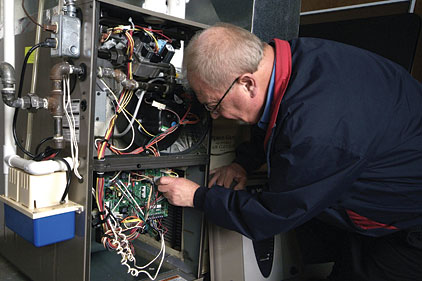
|
| Dave Dombrowski |
During the time the U.S. government offered up to $1,500 in tax credits for higher efficiency appliances, HVAC contractors had the opportunity to get their foot in the doors of consumers who might not normally have considered buying high-end furnaces and air conditioners. The best had taken on new importance in the good-better-best selling scenario.
Since the tax credits were reduced in 2011, the same selling opportunities have dried up too — or have they? Some of The NEWS’ Contractor Panel members recently weighed in on life after the large tax credits and if there are still good opportunities to sell high-end, higher-efficient furnaces this winter season. Most agreed that the focus should not be on tax credits; it should be on what the customer wants and selling them the right system.
“The main issue is that we should never let tax programs be the driving factors in equipment selection,” said Dave Dombrowski of Metro Services/ARS. “This is why there are many homes out there with 5-ton coils on 2-ton systems, causing all sorts of problems. We need to be professionals and recommend the best product for the application.

|
| Brian Leech |
“In a properly designed system (including a properly sealed duct system), a high efficiency furnace will dramatically improve the comfort of the home as well as offer energy savings. Features such as two-stage gas valves and variable-speed blowers offer these benefits for homeowners. The trick to selling them again is proper design and therefore, more comfort. Also, do not forget the benefit of a two-pipe system when it comes to obtaining combustion air and properly sealing the mechanical area.”
Brian Leech of Service Legends is all about giving customers exactly what they want — regardless of the system or its efficiency. “Our focus is on listening to what the client wants and responding with a system that meets those wants,” he said. “Our consideration is always for what the clients want, and we fulfill it — therefore earning the client. It really does not matter about brand or efficiency to us, it only matters that we earn the clients’ business by designing them what they want.
“As far as higher priced equipment, we design with a whole system approach with proper duct moderations, sized properly, and proper installation. This is a rarity in our industry, so we often find ourselves higher than most of our competition anyway.”

|
| Arthur Pickett |
Tim Paetz of Bud Anderson Heating and Cooling puts a premium on the premium — selling equipment that will last and be the most energy efficient. “Since the end of the big tax credits, most good salespeople stay busy because they remember several things,” he said. “First, when we sell a 96 percent modulating furnace, it’s all about the comfort factor. We sell home comfort to our clients and being comfortable includes saving money. These systems are quieter when they run all the time, keeping an even temperature in the home.
“Next, when it comes to saving money, we show customers how the furnace can pay for itself over a period of time usually around 7-10 years, it depends on what they are replacing. As an added selling feature, the warranties we sell with these furnaces are 10-year parts and labor with life time replacement to the original owner. Our clients don’t have to worry about anything for 10 years or more. That’s what you get when you buy high end.”
If customers are still hooked on tax credits and rebates, there are still programs in many states and local municipalities where consumers can get rebates back from utility companies. Arthur Pickett of Royal Air Systems cited an example. “We are fortunate in Massachusetts,” he said. “The gas utilities offer excellent rebates to the consumer for using gas heat [www.gasnetworks.com]. In our state there are many choices. Sixty percent of the existing market is hydronic, so there are lots of choices including separate or combined water heaters, HRV units, aftermarket boiler controls, and programmable thermostats.
“When selling a new furnace replacement, I always start by asking if the consumer plans on staying in the home for five years or more. If the answer is yes, I will explain that the operating cost difference will pay for itself just in the gas savings. Because we sell variable drive blowers (electricity is expensive in Massachusetts) we will save them electrical cost as well.

|
| Jim Hussey |
“If they answer no, I will talk about the trend to automatically have a home inspection by the new purchaser or lending institution. The home inspector will point out the quality and efficiency of the HVAC and the water heater. The operating cost of the home is part of the monthly expense, so now the buyer has one particular variable to think about: utility costs.”
The news about selling high-end furnaces is not good for the commercial sector, according to one member of the Contractor Panel, Jim Hussey of Marina Mechanical. He said that selling high-end, energy-efficient equipment to commercial customers is even more of a challenge, with or without tax credits or rebates.
“The commercial retrofit sector is pretty much stalled,” Hussey said. “Retrofits are hard to sell with or without energy efficiency, as commercial financing is next to impossible to find. Until the banking industry recovers from the mistakes of the last 10 years, property owners will be hard pressed to find the cash needed to maintain or upgrade their properties. Public sector energy projects are still on the move, but only because they still have access to bond money and favorable leasing rules.”
Publication date: 12/12/2011





